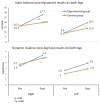Static and Dynamic Balance Indices among Kindergarten Children: A Short-Term Intervention Program during COVID-19 Lockdowns
- PMID: 35883923
- PMCID: PMC9319221
- DOI: 10.3390/children9070939
Static and Dynamic Balance Indices among Kindergarten Children: A Short-Term Intervention Program during COVID-19 Lockdowns
Abstract
The COVID-19 pandemic outbreak had a negative impact on kindergarten activities. These young children, who had been compelled to stay home during lockdowns, suffered a lack of movement and loss of mobility, resulting in deteriorated physical motor skills. Lack of sufficient motor experience in early childhood can impair children's motor and cognitive development. Balance skills are fundamental to all other motor abilities, from the most basic movements to the most complex motor skills. The purpose of this study was to implement a short-term physical activity program, which may have a direct effect on children's fundamental balance ability. Ninety-six kindergarten children (45 boys and 51 girls), aged 4-6 years, participated in the study. Data were analyzed using three-way ANOVA and interaction analyses. The results suggest that short, focused, and dedicated balance training programs have a beneficial influence on the static balance of preschoolers and can mitigate some of the negative physical outcomes of lockdowns. In conclusion, this study indicates that a short-term physical training program had a positive effect on the motor abilities of preschoolers after COVID-19-related lockdowns. More research is needed in order to fully understand the complete impact of the worldwide health crisis and the best ways in which to address it.
Keywords: COVID-19; balance; lockdown; motor learning; motor skills.
Conflict of interest statement
The authors declare no conflict of interest.
Figures
Similar articles
-
The effects of the COVID-19 lockdowns on motor skill development of 6- and 7-year old children in the Netherlands: a longitudinal study.BMC Public Health. 2023 Sep 27;23(1):1871. doi: 10.1186/s12889-023-16733-1. BMC Public Health. 2023. PMID: 37759169 Free PMC article.
-
The effectiveness of web-based programs on the reduction of childhood obesity in school-aged children: A systematic review.JBI Libr Syst Rev. 2012;10(42 Suppl):1-14. doi: 10.11124/jbisrir-2012-248. JBI Libr Syst Rev. 2012. PMID: 27820152
-
An Effective and Playful Way of Practicing Online Motor Proficiency in Preschool Children.Children (Basel). 2024 Jan 20;11(1):130. doi: 10.3390/children11010130. Children (Basel). 2024. PMID: 38275440 Free PMC article.
-
Effect of Novel Rhythmic Physical Activities on Fundamental Movement Skills in 3- to 5-Year-Old Children.Biomed Res Int. 2020 Dec 28;2020:8861379. doi: 10.1155/2020/8861379. eCollection 2020. Biomed Res Int. 2020. PMID: 33426079 Free PMC article. Review.
-
Need to Perform Rehabilitation Exercises at Home by Parents of Children with Neurological Diseases to Maintain Performance During COVID-19 Lockdown.Iran J Child Neurol. 2021 Fall;15(4):9-14. doi: 10.22037/ijcn.v16i1.30019. Iran J Child Neurol. 2021. PMID: 34782837 Free PMC article. Review.
Cited by
-
A comparative study of four physical education curricula on the developmental behavior of Chinese preschool children aged 4 to 6 years and its correlation with balance ability.Front Public Health. 2025 Mar 10;13:1477001. doi: 10.3389/fpubh.2025.1477001. eCollection 2025. Front Public Health. 2025. PMID: 40129582 Free PMC article. Clinical Trial.
-
Effects of Dance Music on Motor Skills and Balance in Children: An Observational Cohort Study.Children (Basel). 2024 Sep 18;11(9):1128. doi: 10.3390/children11091128. Children (Basel). 2024. PMID: 39334660 Free PMC article.
-
Physical Functions among Children before and during the COVID-19 Pandemic: A Prospective Longitudinal Observational Study (Stage 1).Int J Environ Res Public Health. 2022 Sep 13;19(18):11513. doi: 10.3390/ijerph191811513. Int J Environ Res Public Health. 2022. PMID: 36141790 Free PMC article.
-
Is dynamic balance impaired in people with non-specific low back pain when compared to healthy people? A systematic review.Eur J Phys Rehabil Med. 2025 Feb;61(1):72-81. doi: 10.23736/S1973-9087.25.08383-2. Eur J Phys Rehabil Med. 2025. PMID: 40008911 Free PMC article.
References
-
- Goddard Blyth S. Attention, Balance and Coordination: The A.B.C. of Learning Success. 2nd ed. Wiley-Blackwell; Hoboken, NJ, USA: 2017. - DOI
LinkOut - more resources
Full Text Sources


